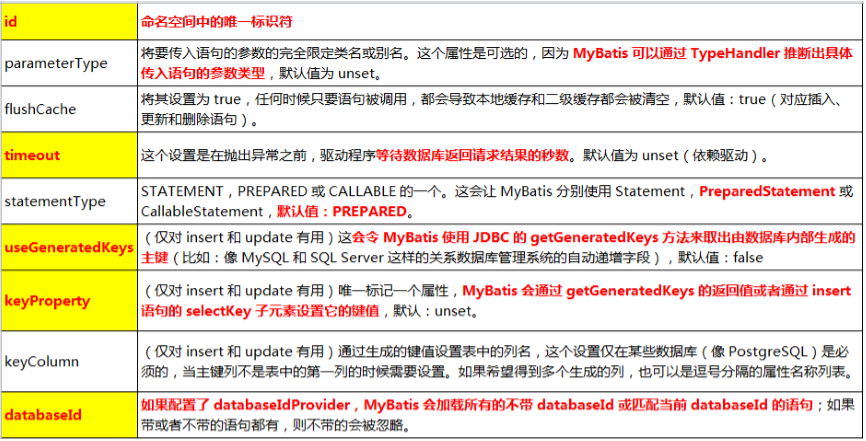MyBatis-映射文件
MyBatis-映射文件
一、insert、update、delete元素

二、主键生成方式
1、获取自增主键的值:
mysql/SQL Server支持自增主键,自增主键值的获取,mybatis也是利用statement.getGenreatedKeys();
useGeneratedKeys="true";使用自增主键获取主键值策略
keyProperty;指定对应的主键属性,也就是mybatis获取到主键值以后,将这个值封装给javaBean的哪个属性<insert id="addEmp" parameterType="com.atguigu.mybatis.bean.Employee" useGeneratedKeys="true" keyProperty="id" databaseId="mysql">
insert into tbl_employee(last_name,email,gender) values(#{lastName},#{email},#{gender})</insert>2、获取非自增主键的值:
Oracle不支持自增;Oracle使用序列来模拟自增;
每次插入的数据的主键是从序列中拿到的值;如何获取到这个值;
keyProperty:查出的主键值封装给javaBean的哪个属性
order="BEFORE":当前sql在插入sql之前运行
AFTER:当前sql在插入sql之后运行
resultType:查出的数据的返回值类型
BEFORE运行顺序:
先运行selectKey查询id的sql;查出id值封装给javaBean的id属性
在运行插入的sql;就可以取出id属性对应的值
AFTER运行顺序:
先运行插入的sql(从序列中取出新值作为id);
再运行selectKey查询id的sql;
<insert id="addEmp" databaseId="oracle">
<selectKey keyProperty="id" order="BEFORE" resultType="Integer"> <!-- 编写查询主键的sql语句 -->
//BEFORE:
select EMPLOYEES_SEQ.nextval from dual
//AFTER:
select EMPLOYEES_SEQ.currval from dual
</selectKey>
<!-- 插入时的主键是从序列中拿到的 --> //BEFORE: insert into employees(EMPLOYEE_ID,LAST_NAME,EMAIL) values(#{id},#{lastName},#{email<!-- ,jdbcType=NULL -->})
//AFTER:
insert into employees(EMPLOYEE_ID,LAST_NAME,EMAIL) values(employees_seq.nextval,#{lastName},#{email}) -->
</insert>

三、参数(Parameters)传递
1、单个参数:mybatis不会做特殊处理,
#{参数名/任意名}:取出参数值。
2、多个参数:mybatis会做特殊处理。
多个参数会被封装成 一个map,
key:param1...paramN,或者参数的索引也可以
value:传入的参数值
#{}就是从map中获取指定的key的值;
异常:
org.apache.ibatis.binding.BindingException:
Parameter 'id' not found.
Available parameters are [1, 0, param1, param2]
操作:
方法:public Employee getEmpByIdAndLastName(Integer id,String lastName);
取值:#{id},#{lastName}
3、【命名参数】:明确指定封装参数时map的key;@Param("id")
多个参数会被封装成 一个map,
key:使用@Param注解指定的值
value:参数值
#{指定的key}取出对应的参数值
POJO:
如果多个参数正好是我们业务逻辑的数据模型,我们就可以直接传入pojo;
#{属性名}:取出传入的pojo的属性值
Map:
如果多个参数不是业务模型中的数据,没有对应的pojo,不经常使用,为了方便,我们也可以传入map
#{key}:取出map中对应的值
TO:
如果多个参数不是业务模型中的数据,但是经常要使用,推荐来编写一个TO(Transfer Object)数据传输对象Page{ int index; int size;
}public Employee getEmp(@Param("id")Integer id,String lastName);
取值:id==>#{id/param1} lastName==>#{param2}public Employee getEmp(Integer id,@Param("e")Employee emp);
取值:id==>#{param1} lastName===>#{param2.lastName/e.lastName}##特别注意:如果是Collection(List、Set)类型或者是数组,
也会特殊处理。也是把传入的list或者数组封装在map中。
key:Collection(collection),如果是List还可以使用这个key(list)、数组(array)
public Employee getEmpById(List<Integer> ids);
取值:取出第一个id的值: #{list[0]}
总结:参数多时会封装map,为了不混乱,我们可以使用@Param来指定封装时使用的key;#{key}就可以取出map中的值
(@Param("id")Integer id,@Param("lastName")String lastName);
ParamNameResolver解析参数封装map的
1、names:{0=id, 1=lastName};构造器的时候就确定好了
确定流程:
1.获取每个标了param注解的参数的@Param的值:id,lastName; 赋值给name;
2.每次解析一个参数给map中保存信息:(key:参数索引,value:name的值)
name的值:
标注了param注解:注解的值
没有标注:
1.全局配置:useActualParamName(jdk1.8):name=参数名 2.name=map.size();相当于当前元素的索引
{0=id, 1=lastName,2=2}
args【1,"Tom",'hello'】:public Object getNamedParams(Object[] args) { final int paramCount = names.size(); //1、参数为null直接返回
if (args == null || paramCount == 0) { return null;
//2、如果只有一个元素,并且没有Param注解;args[0]:单个参数直接返回
} else if (!hasParamAnnotation && paramCount == 1) { return args[names.firstKey()];
//3、多个元素或者有Param标注
} else { final Map<String, Object> param = new ParamMap<Object>(); int i = 0;
//4、遍历names集合;{0=id, 1=lastName,2=2}
for (Map.Entry<Integer, String> entry : names.entrySet()) {
//names集合的value作为key; names集合的key又作为取值的参考args[0]:args【1,"Tom"】: //eg:{id=args[0]:1,lastName=args[1]:Tom,2=args[2]} param.put(entry.getValue(), args[entry.getKey()]);
// add generic param names (param1, param2, ...)param //额外的将每一个参数也保存到map中,使用新的key:param1...paramN //效果:有Param注解可以#{指定的key},或者#{param1}
final String genericParamName = GENERIC_NAME_PREFIX + String.valueOf(i + 1); // ensure not to overwrite parameter named with @Param
if (!names.containsValue(genericParamName)) {
param.put(genericParamName, args[entry.getKey()]);
}
i++;
} return param;
}
}
}===========================参数值的获取======================================#{}:可以获取map中的值或者pojo对象属性的值;
${}:可以获取map中的值或者pojo对象属性的值;
select * from tbl_employee where id=${id} and last_name=#{lastName}
Preparing: select * from tbl_employee where id=2 and last_name=?区别:
#{}:是以预编译的形式,将参数设置到sql语句中;PreparedStatement;防止sql注入
${}:取出的值直接拼装在sql语句中;会有安全问题;
大多情况下,我们去参数的值都应该去使用#{};
原生jdbc不支持占位符的地方我们就可以使用${}进行取值
比如分表、排序。。。;按照年份分表拆分
select * from ${year}_salary where xxx;
select * from tbl_employee order by ${f_name} ${order}#{}:更丰富的用法:
规定参数的一些规则:
javaType、 jdbcType、 mode(存储过程)、 numericScale、
resultMap、 typeHandler、 jdbcTypeName、 expression(未来准备支持的功能);
jdbcType通常需要在某种特定的条件下被设置:
在我们数据为null的时候,有些数据库可能不能识别mybatis对null的默认处理。比如Oracle(报错);
JdbcType OTHER:无效的类型;因为mybatis对所有的null都映射的是原生Jdbc的OTHER类型,oracle不能正确处理;
由于全局配置中:jdbcTypeForNull=OTHER;oracle不支持;两种办法 1、#{email,jdbcType=OTHER}; 2、jdbcTypeForNull=NULL <setting name="jdbcTypeForNull" value="NULL"/>四、resultMap的使用
1、自定义某个javaBean的封装规则
type:自定义规则的Java类型
id:唯一id方便引用<resultMap type="com.atguigu.mybatis.bean.Employee" id="MySimpleEmp"> 指定主键列的封装规则:
id定义主键会底层有优化;
column:指定哪一列
property:指定对应的javaBean属性
<id column="id" property="id"/> //定义普通列封装规则
<result column="last_name" property="lastName"/> 其他不指定的列会自动封装:我们只要写resultMap就把全部的映射规则都写上
<result column="email" property="email"/>
<result column="gender" property="gender"/>
</resultMap>
resultMap:自定义结果集映射规则 resultType与resultMap只能选择一个接口方法:public Employee getEmpById(Integer id);<select id="getEmpById" resultMap="MySimpleEmp">
select * from tbl_employee where id=#{id}</select>
2、association的使用:
场景一:查询Employee的同时查询员工对应的部门
一个员工有与之对应的部门信息:id last_name email gender d_id did dept_name
方法1、联合查询:级联属性封装结果集<resultMap type="com.atguigu.mybatis.bean.Employee" id="MyDifEmp"> <id column="id" property="id"/> <result column="last_name" property="lastName"/> <result column="gender" property="gender"/> <result column="did" property="dept.id"/> <result column="dept_name" property="dept.departmentName"/> </resultMap>
方法2:使用association定义关联的单个对象的封装规则;<resultMap type="com.atguigu.mybatis.bean.Employee" id="MyDifEmp2"> <id column="id" property="id"/> <result column="last_name" property="lastName"/> <result column="gender" property="gender"/> association可以指定联合的javaBean对象 property="dept":指定哪个属性是联合的对象 javaType:指定这个属性对象的类型[不能省略] <association property="dept" javaType="com.atguigu.mybatis.bean.Department"> <id column="did" property="id"/> <result column="dept_name" property="departmentName"/> </association> </resultMap>
接口方法:public Employee getEmpAndDept(Integer id);<select id="getEmpAndDept" resultMap="MyDifEmp"> SELECT e.id id,e.last_name last_name,e.gender gender,e.d_id d_id,d.id did,d.dept_name dept_name
FROM tbl_employee e,tbl_dept d WHERE e.d_id=d.id AND e.id=#{id}</select> 方法3:使用association进行分步查询: 1、先按照员工id查询员工信息 2、根据查询员工信息中的d_id值去部门表查出部门信息 3、部门设置到员工中; <!-- id last_name email gender d_id --> <resultMap type="com.atguigu.mybatis.bean.Employee" id="MyEmpByStep"> <id column="id" property="id"/> <result column="last_name" property="lastName"/> <result column="email" property="email"/> <result column="gender" property="gender"/> association定义关联对象的封装规则: select:表明当前属性是调用select指定的方法查出的结果 column:指定将哪一列的值传给这个方法 流程:使用select指定的方法(传入column指定的这列参数的值)查出对象,并封装给property指定的属性 <association property="dept" select="com.atguigu.mybatis.dao.DepartmentMapper.getDeptById" column="d_id"> </association> </resultMap>
//接口方法:public Employee getEmpByIdStep(Integer id);<select id="getEmpByIdStep" resultMap="MyEmpByStep">
select * from tbl_employee where id=#{id} <if test="_parameter!=null">
and 1=1
</if>
</select>
可以使用延迟加载(懒加载);(按需加载) Employee==>Dept:每次查询Employee对象的时候,都将一起查询出来。
若要求部门信息在我们使用的时候再去查询,可以在分段查询的基础之上在mybatis-config.xml加上两个配置:<setting name="lazyLoadingEnabled" value="true"/>
<setting name="aggressiveLazyLoading" value="false"/>
场景二:查询部门的时候将部门对应的所有员工信息也查询出来:注释在DepartmentMapper.xml中
部门对应的员工信息:did dept_name || eid last_name email gender

接口方法:public List<Employee> getEmpsByDeptId(Integer deptId);
EmployeeMapper.xml中的配置<select id="getEmpsByDeptId" resultType="com.atguigu.mybatis.bean.Employee">
select * from tbl_employee where d_id=#{deptId}</select>
DepartmentMapper.xml中的配置:
方法1:嵌套结果集的方式,使用collection标签定义关联的集合类型的属性封装规则<resultMap type="com.atguigu.mybatis.bean.Department" id="MyDept">
<id column="did" property="id"/>
<result column="dept_name" property="departmentName"/>
collection定义关联集合类型的属性的封装规则:
ofType:指定集合里面元素的类型
<collection property="emps" ofType="com.atguigu.mybatis.bean.Employee"> 定义这个集合中元素的封装规则 -->
<id column="eid" property="id"/>
<result column="last_name" property="lastName"/>
<result column="email" property="email"/>
<result column="gender" property="gender"/>
</collection>
</resultMap>
//接口方法:public Department getDeptByIdPlus(Integer deptId);<select id="getDeptByIdPlus" resultMap="MyDept">
SELECT d.id did,d.dept_name dept_name,e.id eid,e.last_name last_name,e.email email,e.gender gender
FROM tbl_dept d
LEFT JOIN tbl_employee e
ON d.id=e.d_id
WHERE d.id=#{id}</select> 方法2:collection:分段查询 --><resultMap type="com.atguigu.mybatis.bean.Department" id="MyDeptStep">
<id column="id" property="id"/>
<id column="dept_name" property="departmentName"/>
<collection property="emps"
select="com.atguigu.mybatis.dao.EmployeeMapperPlus.getEmpsByDeptId"
column="{deptId=id}" fetchType="lazy"></collection> //fetchType="lazy":表示使用延迟加载;- lazy:延迟;- eager:立即
</resultMap>
//接口方法:public Department getDeptByIdStep(Integer deptId);<select id="getDeptByIdStep" resultMap="MyDeptStep">
select id,dept_name from tbl_dept where id=#{id}</select>

